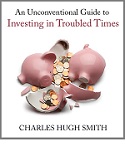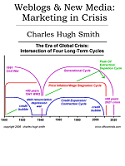

|

|
|||||||||||||
|
Real Estate: Is the Bottom In, or Is This a Head-Fake? (December 10, 2012) Everyone interested in real estate is asking the same question: Is the bottom in, or is this just another “green shoots” recovery that will soon wilt? Let’s start by reviewing the fundamental forces currently affecting real estate valuations. Expanding the pool of potential buyers has reached the upper limitThere are two ways to expand the pool of qualified home buyers, and they both rely on expanding leverage: A) lower the down payment from 20% cash to 3%, and B) lower the mortgage rate to 3.5%. The mortgage industry has escaped any consequences of “robo-signing” mortgage fraudIf the rule of law existed in more than name, this is what should have happened:
That none of this has happened is proof that the rule of law is “optional” for financial institutions in America.
In other words, the financial sector has gotten away with murder, and the “overhang” of systemic fraud has been erased with Fed connivance. Banks are restricting inventoryThe banks are withholding distressed properties to restrict the inventory of homes for sale. If supply overwhelms demand, prices decline. That would be a bad thing for banks sitting on millions of defaulted mortgages and distressed properties. Millions of impaired properties are being held off the market so supply is lower than demand. Since the strategy has paid such handsome returns, why change it? ZIRP has attracted investmentThe Fed’s ZIRP (zero interest rate policy) has pushed investors into a “search for safe yield” that has led many to buy corporate bonds, dividend stocks and everyone’s favorite “safe” fixed asset, real estate. In many markets, one-third or more of all sales have been to investors. “The bottom is in” – isn't it?Once potential buyers see prices rise and they conclude that “the bottom is in,” they jump in and buy, pushing prices higher in a positive feedback loop. The higher prices rise, the more evidence there is that the bottom is in, and the greater the incentives to jump in before prices once again rise out of reach. Favorable rent/buy ratioWith mortgage rates well below 4%, the rent-buy ratio is favorable in many areas. It may indeed be cheaper to buy than to rent in some locales. “Hot money” flowing into real-estateAs economies in Europe and Asia falter, “hot money” is flowing into perceived “safe havens” such as the U.S. and Canada. Some of this “hot money” ($225-$300 billion a year is leaving China alone) is flowing into real estate, a well-known phenomenon in markets such as Vancouver, B.C., Miami, and Los Angeles. ConclusionWhat can we conclude from this overview of fundamentals?
The question now is will these forces continue pushing prices higher? If so, the bottom may well be in. If these forces deteriorate or lose their effectiveness, then the “green shoots” of investor interest may wither as the U.S. economy joins Europe and Japan by re-entering recession. In Part II: Forecasting the Future of Rental Housing and Home Valuations, we will examine what forces could change "the bottom is in!" to "this is just another head-fake" -- with the real bottom is still ahead. Click here to read Part II of this report (free executive summary; enrollment required for full access).
This article was first published on
peakprosperity.com, where I am a contributing writer.
Things are falling apart--that is obvious. But why are they falling
apart? The reasons are complex and global. Our economy and society have structural
problems that cannot be solved by adding debt to debt. We are becoming poorer, not
just from financial over-reach, but from fundamental forces that are not easy to identify
or understand. We will cover the five core reasons why things are falling apart:
 1. Debt and financialization
1. Debt and financialization
2. Crony capitalism and the elimination of accountability 3. Diminishing returns 4. Centralization 5. Technological, financial and demographic changes in our economy Complex systems weakened by diminishing returns collapse under their own weight and are replaced by systems that are simpler, faster and affordable. If we cling to the old ways, our system will disintegrate. If we want sustainable prosperity rather than collapse, we must embrace a new model that is Decentralized, Adaptive, Transparent and Accountable (DATA).
We are not powerless. Not accepting responsibility and being powerless are two sides of
the same coin: once we accept responsibility, we become powerful.
To receive a 20% discount
on the print edition: $19.20 (retail $24), follow the link, open a Createspace account and enter
discount code SJRGPLAB. (This is the only way I can offer a discount.)




Please click on a book cover to read sample chapters
NOTE: gifts/contributions are acknowledged in the order received. Your name and email remain confidential and will not be given to any other individual, company or agency.
"This guy is THE leading visionary on reality.
He routinely discusses things which no one else has talked about, yet,
turn out to be quite relevant months later."
Or send him coins, stamps or quatloos via mail--please request P.O. Box address. Subscribers ($5/mo) and contributors of $50 or more this year will receive a weekly email of exclusive (though not necessarily coherent) musings and amusings. At readers' request, there is also a $10/month option. What subscribers are saying about the Musings (Musings samples here): The "unsubscribe" link is for when you find the usual drivel here insufferable.
All content, HTML coding, format design, design elements and images copyright © 2012 Charles Hugh Smith, All rights reserved in all media, unless otherwise credited or noted. I am honored if you link to this essay, or print a copy for your own use.
Terms of Service:
|
Add oftwominds.com |